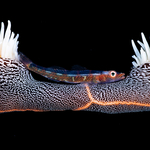Offering crystal-clear warm waters teeming with marine life large and small, the Sea of Cortez is an unmissable highlight of Mexico diving. This world-class destination is all about big wildlife; from playful sea lions and friendly grey whales to abundant mobulas, mantas and whale sharks. Added to that, the Sea of Cortez offers stunning coral reef diving at the oldest reef on the west coast of North America. Read on to find out more and plan your next adventure now.
THE SEA OF CORTEZ – YOUR QUESTIONS ANSWERED.
Where is the Sea of Cortez?
The Sea of Cortez, also known as the Gulf of California, sits between Mexico’s Baja California Peninsula and the Mexican mainland. Being sheltered from the open ocean, it offers outstanding year-round diving in mostly calm waters.
How do you get to the Sea of Cortez?
You can get to the Sea of Cortez easily by airplane. Cabo Pulmo and Cabo San Lucas are serviced by Los Cabos International Airport. To reach La Paz, you can either fly into San José del Cabo or La Paz Leon Airport. Loreto is accessed by flying into Loreto Airport from Mexico City, Guadalajara and Los Angeles.
Where can you dive in the Sea of Cortez?
There are top dive destinations scattered along the Sea of Cortez’s coastline. La Paz and Cabo Pulmo are two of the most popular, though there is also great diving at Loreto and other coastal destinations.
Can you snorkel in the Sea of Cortez?
Yes! The Sea of Cortez has fantastic snorkeling opportunities and thriving marine life in the shallows. It is an ideal place to go snorkeling and diving, relax on pristine beaches and soak up the sunshine.
Is there liveaboard diving in the Sea of Cortez?
Absolutely. Joining a liveaboard safari is one of the best ways to go diving in the Sea of Cortez and allows you to reach the more remote dive sites. Liveaboards to the Sea of Cortez depart from La Paz, Cabo San Lucas and Puerto Peñasco.
Most liveaboards visit the Sea of Cortez from July to October.
Shore diving is possible all year.
READ MORE: TOP TIPS & TRICKS FOR DIVING ON A LIVEABOARD.
MEXICO DIVING – ESSENTIAL INFO TO PLAN YOUR TRIP.
Experience level needed.
The Sea of Cortez is mostly calm and has dive sites suitable for new and experienced divers. There are however times of the year when it can be rough, so it is best to be prepared for that possibility. Have a chat with your dive operator to find out what will work for you or check out our seasonal dive conditions below.
The best time to visit.
The best time to visit depends on what marine life you want to see during your Sea of Cortez diving trip:
December to March is all about pelagics, including grey whales, humpbacks and mobula rays.
July to December is the best time to see whale sharks.
Visit from September to November to see young whale sharks.
Sea lions are present all year and you can spot playful pups during September.
READ MORE: MEXICO’S BEST DIVING PT 1 – THE SOCORRO ISLANDS.
Seasonal temperatures.
The Sea of Cortez has a warm sub-tropical climate, so expect hot days in summer and cool nights:
Air temperatures range from 15 to 29 °C (59 – 85 °F).
Water temperatures range from 15 to 32 °C (59 – 89 °F).
Seasonal dive conditions.
When planning your Mexico diving trip, think about how cold you usually get in the water and your comfort at sea. For the Sea of Cortez:
December to March has the coolest waters and poorer visibility. It can be rough and windy then.
July to December has great visibility and warm waters.
September and October are the absolute best months for flat seas and peak visibility.
Water visibility.
Water visibility at the Sea of Cortez ranges from 9 to 25 meters (30 – 82 feet).
TAKE CONTROL NO MATTER THE CONDITIONS – SSI WAVES, TIDES & CURRENTS.
MEXICO DIVING – WHERE TO GO IN THE SEA OF CORTEZ.
La Paz
La Paz, the capital of Baja California, is the perfect place to experience some of the best Mexico diving. Bordered by arid hillsides, this tranquil town has turquoise waters, idyllic sandy coves and easy access to world-class scuba diving. Jacques Cousteau could not have described it better when he said the Sea of Cortez is the ‘aquarium of the world’, and La Paz is no exception.
Los Islotes, a colony of over 200 Californian Brown sea lions, is the place to go swimming with sea lions. As well as hosting plenty of cheeky sea lions, Los Islotes has shallow dive sites suitable for all levels and is a popular night diving spot.
The Baja Seamounts are ideal for advanced and experienced divers visiting La Paz. Washed by strong currents, these seamounts attract mobula rays, turtles and whales. You can sometimes also see hammerhead sharks, humpbacks and sperm whales there.
Wherever you choose to dive at La Paz, the waters are bustling with reef and pelagic fish, groupers, moray eels and more.
Love wrecks? Go wreck diving at the Fang Ming and Salvatierra wrecks near La Paz. They are both thriving artificial reefs.
Cabo Pulmo
When you ask about Mexico diving and the Sea of Cortez, two things always get mentioned – huge schools of fish and mobula rays! The Cabo Pulmo National Park is renowned for both and is also home to the oldest reef on the west coast of North America, which is a staggering 20,000 years old.
This ancient reef hosts more than 6000 different marine life species and offers spectacular coral reef diving. If you love underwater photography, go there. Macro fans will be delighted with the array of hidden treasures to find, whilst other divers enjoy diving with bull sharks, sea turtles, mobula rays, astonishingly large schools of jacks and colorful reef fish.
Tens of thousands of mobula rays visit the Sea of Cortez every year, creating one of nature’s most impressive spectacles. You can see thousands of these rays in the waters off Cabo San Lucas, Los Cabos, Loreto and Cabo Pulmo. Attracted in spring by plankton blooms, these acrobatic rays gather in huge groups to mate and give birth.
Go Mexico diving from March to late November for the best chance of snorkeling with mobula rays.
Visit Isla San Pedro to go swimming with sea lions.
TOP TRAINING FOR MEXICO DIVING: MANTA & RAY ECOLOGY
Loreto
Sitting on the east coast of Baja California Sur, Loreto offers a wonderful mixture of old-world Mexican charm and luxury amenities. With the impressive Sierra Giganta mountains to the west and the ocean on its doorstep, Loreto is a great place to combine diving in the Sea of Cortez with adventure activities and a spot of pampering.
The nearby islands host plenty of accessible dive sites, many of which sit in the protected waters of the Parque Maritimo Nacional Bahia de Loreto. Expect striking underwater cliffs and deep walls that plunge into the inky depths, caves and boulder-strewn landscapes. There you will find abundant fish life and huge sea fans. All of which make Loreto a top highlight of Mexico diving.
Go diving at La Lobera, a magnificent wall dive site with deep caves, caverns and black corals.
San Ignacio
Mexico is famous for its friendly grey whales, which migrate to the shallow waters of San Ignacio Lagoon to mate and calve from January to April each year. Whilst you cannot go diving with these charming whales, you can take a boat trip from San Ignacio to meet them.
CLICK HERE TO EXPLORE TOP DIVE SITES IN THE SEA OF CORTEZ.
The post Discover the best Mexico Diving Part 2 – Sea of Cortez appeared first on Dive SSI.
Read MoreDiving, Travel, mexico, Mexico diving, sea of cortezDive SSI


